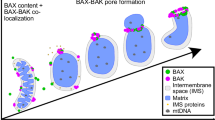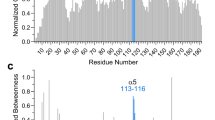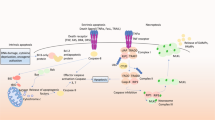Abstract
Bax is a proapoptotic protein that is required for programmed cell death (PCD) of many neuronal populations. Here we show that, during an early period of retinal PCD and in naturally occurring sensory and motor neuron (MN) death in the spinal cord, Bax delivery results in enhanced death of these neural populations. In contrast, Bax overexpression fails to enhance an early phase of MN death that occurs in the cervical spinal cord, although overexpressed Bax appears to be activated in dying MNs. Bax overexpression does not also affect the survival of immature neurons prior to the PCD period. Taken together, these data provide the first in vivo evidence suggesting that Bax appears to act selectively as an executioner only in neurons undergoing PCD. Furthermore, although Bax appears to mediate the execution pathway for PCD, the effect of Bax overexpression on susceptibility to death differs between different neuronal populations.
Similar content being viewed by others
Log in or create a free account to read this content
Gain free access to this article, as well as selected content from this journal and more on nature.com
or
Abbreviations
- DRG:
-
dorsal root ganglion
- EGFP:
-
enhanced green fluorescent protein
- hBax:
-
human Bax
- HSP:
-
heat shock protein
- MN:
-
motor neuron
- PCD:
-
programmed cell death
- STS:
-
staurosporine
- VH:
-
ventral horn
References
Merry DE and Korsmeyer SJ (1997) Bcl-2 gene family in the nervous system. Annu. Rev. Neurosci. 20: 245–267
Deckwerth TL, Elliott JL, Knudson CM, Johnson Jr EM, Snider WD and Korsmeyer SJ (1996) BAX is required for neuronal death after trophic factor deprivation and during development. Neuron 17: 401–411
Vekrellis K, McCarthy MJ, Watson A, Whitfield J, Rubin LL and Ham J (1997) Bax promotes neuronal cell death and is downregulated during the development of the nervous system. Development 124: 1239–1249
White FA, Keller-Peck CR, Knudson CM, Korsmeyer SJ and Snider WD (1998) Widespread elimination of naturally occurring neuronal death in Bax-deficient mice. J. Neurosci. 18: 1428–1439
Sun W, Gould TW, Vinsant S, Prevette D and Oppenheim RW (2003) Neuromuscular development after the prevention of naturally occurring neuronal death by Bax deletion. J. Neurosci. 23: 7298–7310
Shindler KS, Latham CB and Roth KA (1997) Bax deficiency prevents the increased cell death of immature neurons in bcl-x-deficient mice. J. Neurosci. 17: 3112–3119
Wolter KG, Hsu YT, Smith CL, Nechushtan A, Xi XG and Youle RJ (1997) Movement of Bax from the cytosol to mitochondria during apoptosis. J. Cell Biol. 139: 1281–1292
Nechushtan A, Smith CL, Hsu YT and Youle RJ (1999) Conformation of the Bax C-terminus regulates subcellular location and cell death. EMBO J. 18: 2330–2341
Putcha GV, Deshmukh M and Johnson Jr EM (1999) BAX translocation is a critical event in neuronal apoptosis: regulation by neuroprotectants, BCL-2, and caspases. J. Neurosci. 19: 7476–7485
Vogelbaum MA, Tong JX and Rich KM (1998) Developmental regulation of apoptosis in dorsal root ganglion neurons. J. Neurosci. 18: 8928–8935
Paradis E, Douillard H, Koutroumanis M, Goodyer C and LeBlanc A (1996) Amyloid beta peptide of Alzheimer's disease downregulates Bcl-2 and upregulates bax expression in human neurons. J. Neurosci. 16: 7533–7539
Vukosavic S, Dubois-Dauphin M, Romero N and Przedborski S (1999) Bax and Bcl-2 interaction in a transgenic mouse model of familial amyotrophic lateral sclerosis. J. Neurochem. 73: 2460–2468
O'Dell DM, Raghupathi R, Crino PB, Eberwine JH and McIntosh TK (2000) Traumatic brain injury alters the molecular fingerprint of TUNEL-positive cortical neurons in vivo: a single-cell analysis. J. Neurosci. 20: 4821–4828
Brojatsch J, Naughton J, Rolls MM, Zingler K and Young JA (1996) CAR1, a TNFR-related protein, is a cellular receptor for cytopathic avian leukosis-sarcoma viruses and mediates apoptosis. Cell 87: 845–855
Sato N, Sakuma C, Kato H, Milligan CE, Oppenheim RW and Yaginuma H (2002) Bcl-2 rescues motoneurons from early cell death in the cervical spinal cord of the chicken embryo. J. Neurobiol. 53: 381–390
Himly M, Foster DN, Bottoli I, Iacovoni JS and Vogt PK (1998) The DF-1 chicken fibroblast cell line: transformation induced by diverse oncogenes and cell death resulting from infection by avian leukosis viruses. Virology 248: 295–304
Schaefer-Klein J, Givol I, Barsov EV, Whitcomb JM, VanBrocklin M, Foster DN, Federspiel MJ and Hughes SH (1998) The EV-O-derived cell line DF-1 supports the efficient replication of avian leukosis-sarcoma viruses and vectors. Virology 248: 305–311
Wei MC, Zong WX, Cheng EH, Lindsten T, Panoutsakopoulou V, Ross AJ, Roth KA, MacGregor GR, Thompson CB and Korsmeyer SJ (2001) Proapoptotic BAX and BAK: a requisite gateway to mitochondrial dysfunction and death. Science 292: 727–730
Frade JM, Bovolenta P, Martinez-Morales JR, Arribas A, Barbas JA and Rodriguez-Tebar A (1997) Control of early cell death by BDNF in the chick retina. Development 124: 3313–3320
Cuadros MA and Rios A (1988) Spatial and temporal correlation between early nerve fiber growth and neuroepithelial cell death in the chick embryo retina. Anat. Embryol 178: 543–551
Caldero J, Prevette D, Mei X, Oakley RA, Li L, Milligan C, Houenou L, Burek M and Oppenheim RW (1998) Peripheral target regulation of the development and survival of spinal sensory and motor neurons in the chick embryo. J. Neurosci. 18: 356–370
Patel TD, Jackman A, Rice FL, Kucera J and Snider WD (2000) Development of sensory neurons in the absence of NGF/TrkA signaling in vivo. Neuron 25: 345–357
Sato N, Matsuda K, Sakuma C, Foster DN, Oppenheim RW and Yaginuma H (2002) Regulated gene expression in the chicken embryo by using replication-competent retroviral vectors. J. Virol. 76: 1980–1985
Homma S, Yaginuma H and Oppenheim RW (1994) Programmed cell death during the earliest stages of spinal cord development in the chick embryo: a possible means of early phenotypic selection. J. Comp. Neurol. 345: 377–395
Yaginuma H, Tomita M, Takashita N, McKay SE, Cardwell C, Yin QW and Oppenheim RW (1996) A novel type of programmed neuronal death in the cervical spinal cord of the chick embryo. J. Neurosci. 16: 3685–3703
Itasaki N, Bel-Vialar S and Krumlauf R (1999) ‘Shocking’ developments in chick embryology: electroporation and in ovo gene expression. Nat. Cell Biol. 1: E203–E207
Thaler J, Harrison K, Sharma K, Lettieri K, Kehrl J and Pfaff SL (1999) Active suppression of interneuron programs within developing motor neurons revealed by analysis of homeodomain factor HB9. Neuron 23: 675–687
Tsuchida T, Ensini M, Morton SB, Baldassare M, Edlund T, Jessell TM and Pfaff SL (1994) Topographic organization of embryonic motor neurons defined by expression of LIM homeobox genes (see comment). Cell 79: 957–970
Oltvai ZN, Milliman CL and Korsmeyer SJ (1993) Bcl-2 heterodimerizes in vivo with a conserved homolog, Bax, that accelerates programmed cell death. Cell 74: 609–619
Frade JM, Rodriguez-Tebar A and Barde YA (1996) Induction of cell death by endogenous nerve growth factor through its p75 receptor. Nature 383: 166–168
Dunker N, Schuster N and Krieglstein K (2001) TGF-beta modulates programmed cell death in the retina of the developing chick embryo. Development 128: 1933–1942
Oppenheim RW (1991) Cell death during development of the nervous system. Annu. Rev. Neurosci. 14: 453–501
Benn SC, Perrelet D, Kato AC, Scholz J, Decosterd I, Mannion RJ, Bakowska JC and Woolf CJ (2002) Hsp27 upregulation and phosphorylation is required for injured sensory and motor neuron survival. Neuron 36: 45–56
Yaginuma H, Shiraiwa N, Shimada T, Nishiyama K, Hong J, Wang S, Momoi T, Uchiyama Y and Oppenheim RW (2001) Caspase activity is involved in, but is dispensable for, early motoneuron death in the chick embryo cervical spinal cord. Mol. Cell. Neurosci. 18: 168–182
Sato N, Wang S, Li L, Okabe K, Hashimoto M, Yaginuma H, Mikoshiba K, Uchiyama Y, Uetsuki T, Yoshikawa K, Milligan CE and Oppenheim RW (1998) A novel strategy for introducing exogenous bcl-2 into neuronal cells: the Cre/loxP system-mediated activation of bcl-2 for preventing programmed cell death using recombinant adenoviruses. Mol. Cell. Neurosci. 12: 65–78
Oppenheim RW, Flavell RA, Vinsant S, Prevette D, Kuan CY and Rakic P (2001) Programmed cell death of developing mammalian neurons after genetic deletion of caspases. J. Neurosci. 21: 4752–4760
Morgan BA and Fekete DM (1996) Manipulating gene expression with replication-competent retroviruses. Methods Cell Biol. 51: 185–218
Hamburger V and Hamilton HL (1992) A series of normal stages in the development of the chick embryo. 1951. [see comment]. Dev. Dyn. 195: 231–272
Acknowledgements
This work is supported by Grant-in-Aid for Scientific Research (14580731, 15590165, 16500223, 17590167) and by the Fukushima Society for the Promotion of Medicine, by the NIH (NS020402) and by a grant from the Robert Packard ALS Center of Johns Hopkins University. We wish to thank the Department of Anatomy for its generous support. We also thank H. Ohuchi for technical assistance, S. H. Hughes for a RSV-derived retroviral plasmid RCASBP(A), B. A. Morgan for an adaptor plasmid Slax13Nco, S. L. Pfaff for a HB9 promoter plasmid, and Y. Tsujimoto for the human bax cDNA.
Author information
Authors and Affiliations
Corresponding author
Additional information
Edited by JC Martinou
Supplementary Information accompanies the paper on Cell Death and Diffrentiation website (http://www.nature.com/cdd).
Rights and permissions
About this article
Cite this article
Sato, N., Sakuma, C., Sato, Y. et al. Distinct susceptibility of developing neurons to death following Bax overexpression in the chicken embryo. Cell Death Differ 13, 435–445 (2006). https://doi.org/10.1038/sj.cdd.4401760
Received:
Revised:
Accepted:
Published:
Issue date:
DOI: https://doi.org/10.1038/sj.cdd.4401760
Keywords
This article is cited by
-
Intrinsic response of thoracic propriospinal neurons to axotomy
BMC Neuroscience (2010)
-
Long descending cervical propriospinal neurons differ from thoracic propriospinal neurons in response to low thoracic spinal injury
BMC Neuroscience (2010)



